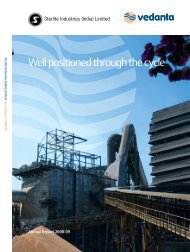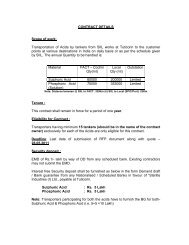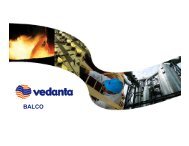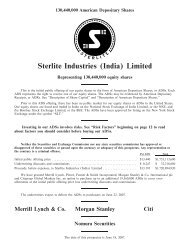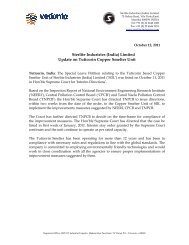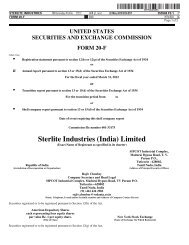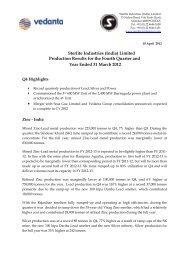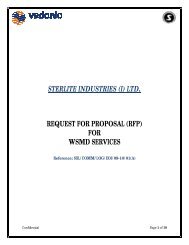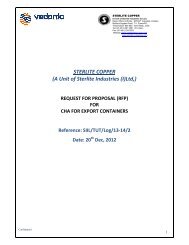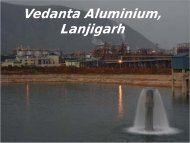Sterlite Industries (India) Limited - Sterlite Industries India Ltd.
Sterlite Industries (India) Limited - Sterlite Industries India Ltd.
Sterlite Industries (India) Limited - Sterlite Industries India Ltd.
Create successful ePaper yourself
Turn your PDF publications into a flip-book with our unique Google optimized e-Paper software.
Bauxite Mines<br />
Chhattisgarh Mines<br />
The Chhattisgarh mines and deposits comprise the operating mines at Mainpat and Bodai-Daldali. Mainpat is an open-pit bauxite mine<br />
located approximately 170 kilometers from the Korba complex in the Surguja district of the State of Chhattisgarh in central <strong>India</strong>. The Mainpat<br />
mine was commissioned in 1993 and lies within a mining lease granted by the Government of <strong>India</strong> which is due for renewal on July 8, 2012.<br />
The mining lease covers an area of 6.39 square kilometers. The bauxite extraction limit for the mine approved by the IBM is 750,000 tpa. The<br />
Bodai-Daldali deposits are located approximately 260 kilometers from Korba in the Kawardhha district of the State of Chhattisgarh. Bodai-<br />
Daldali was commissioned in 2004 by BALCO and lies within a 6.3 square kilometers renewable mining lease that is valid until March 27,<br />
2017. The bauxite extraction limit for Bodai-Daldali approved by the IBM is 1,250,000 tpa.<br />
The Chhattisgarh bauxite deposits are situated on a series of steep sided plateau at an elevation of approximately 1,000 meters, for Mainpat,<br />
and approximately 500 meters, for Bodai-Daldali, above the surrounding land. The bauxite generally is one meter to three meters thick and lies<br />
within a laterite sequence overlying thick Tertiary basalts of the Deccan Traps. The cover of laterite and thin topsoil is up to five meters thick<br />
but is generally less than two meters. The bauxite outcrops around much of the plateau rims and is also visible as boulders strewn across fields<br />
topping the edge of the plateau.<br />
A typical profile of the Chhattisgarh deposits comprises topsoil and soft overburden above the laterite. The upper laterite consists of hard,<br />
loose or indurated bauxite pebbles and boulders with a clear contact with the underlying hard bauxites. The bauxite occurs in discontinuous<br />
lenses up to six meters in thickness with laterite infilling joints and fractures with the bauxite. The contact with the softer lower laterite is<br />
usually gradational and irregular.<br />
The bauxite is hard to very hard with a natural moisture content of 5% to 10%, an in-situ density of 2.3 tons to 2.4 tons per cubic meter and<br />
a low porosity (less than 2%). It comprises primarily gibbsite with boehmite and minor diaspore. The reactive silica content is low and iron is<br />
present in the form of hematite and aluminous goethite. The average grade of the bauxite is, at present, approximately 47% aluminum oxide<br />
(available alumina is approximately 41%) and silica levels of less than 4%.<br />
All mining and transportation at Mainpat is undertaken by contractors. One thin top soil layer is removed by excavator and is either<br />
transported to an adjacent storage point or an area that is being backfilled. The laterite layer is drilled and blasted. The overburden is then<br />
removed by backhoe excavators and 15-ton trucks. Broken ore is hand-sorted, leaving waste material behind. Ore productivity is around two<br />
tons per person per day in the dry season, dropping to around 1.25 tons per person per day in the wet season. Excavator loading is employed in<br />
areas where bauxite deposit is more consistent.<br />
The ore pile is loaded by hand into non-tipping 16 to 25-ton trucks. Loaded trucks undertake a one-way trip of approximately 210<br />
kilometers via public roads to the offloading point at BALCO’s Korba plant. The journey takes approximately six to seven hours depending<br />
upon truck condition and road conditions which are highly variable, ranging from seven-meter wide, drained, cambered, smooth bitumen<br />
highways to non-surfaced, ungraded, three meter wide dirt tracks. In May 2009, BALCO commissioned an extensive road building and<br />
improvement program to reduce the average one-way haul distance from approximately 250 kilometers to approximately 140 kilometers. At<br />
Mainpat’s processing site, the trucks are unloaded manually and the bauxite is bulldozed onto an armored pan feeder conveyor, where it is fed<br />
into the crusher.<br />
The current exploration drilling program is based on a 50-meter square pattern and is reduced to 25 meter centers for detailed mine<br />
planning. Sampling is normally in 0.40 meter lengths and core is currently split and retained for future reference. Bauxite samples are tested for<br />
silica and aluminum oxide at laboratories situated on site and at the Korba plant. Selected samples are re-assayed as part of a quality control<br />
program.<br />
Since commencing operations, the Mainpat mine has produced approximately 5.5 million tons of bauxite, with production in fiscal 2009<br />
totaling approximately 571,422 tons at 44.7% aluminum oxide. Our operations are subject to extensive governmental and environmental<br />
regulations which have in the past and could in the future cause us to incur significant costs or liabilities or interrupt or close our operations.<br />
Power and water requirements at Mainpat are minimal and can be supplied by small on-site diesel generators and from boreholes in the<br />
mine.<br />
BALCO estimates the reserves at Mainpat as of March 31, 2009 to be 3.3 million tons and, based on current and anticipated production<br />
rates, expects that the mine will continue to operate for approximately five years from April 1, 2009.<br />
Total production at the Bodai-Daldali mine since the commencement of production has been 1,220,847 tons of bauxite, with production in<br />
fiscal 2009 totaling approximately 300,250 tons at 49.1% aluminum oxide. As at the Mainpat mine, manual sorting and sizing of ore is carried<br />
out due to the bauxite occurring as boulders, though trials for mechanized crushing and screening on-site are planned. Power is supplied by onsite<br />
diesel generators and ground water provides the water requirements for the mine.<br />
BALCO estimates the reserves at Bodai-Daldali as of March 31, 2009 to be 3.8 million tons and, based on current and anticipated<br />
production rates, expects that the mine will continue to operate for approximately five years from April 1, 2009.<br />
A cut-off grade of 44% aluminum oxide was used to define the reserves at BALCO’s mines, which cut-off grade was primarily defined by<br />
geological limits. As the bauxite is hand-sorted and the mining recovery adjustment factor is based on reconciliation studies, there is a high<br />
degree of confidence in the cut-off limits. Also, BALCO’s operations are vertically integrated and all bauxite mined at the Mainpat and Bodai-<br />
Daldali mines is only suitable for use at BALCO’s Korba alumina refinery. Consequently, the economic feasibility of the reserves depends on<br />
the economic feasibility of the company. Based on current costs and historical prices, BALCO’s operations are forecast to remain profitable<br />
and therefore the deposits at the Mainpat and Bodai-Daldali mines fulfill the requirements for being classified as reserves.<br />
48



